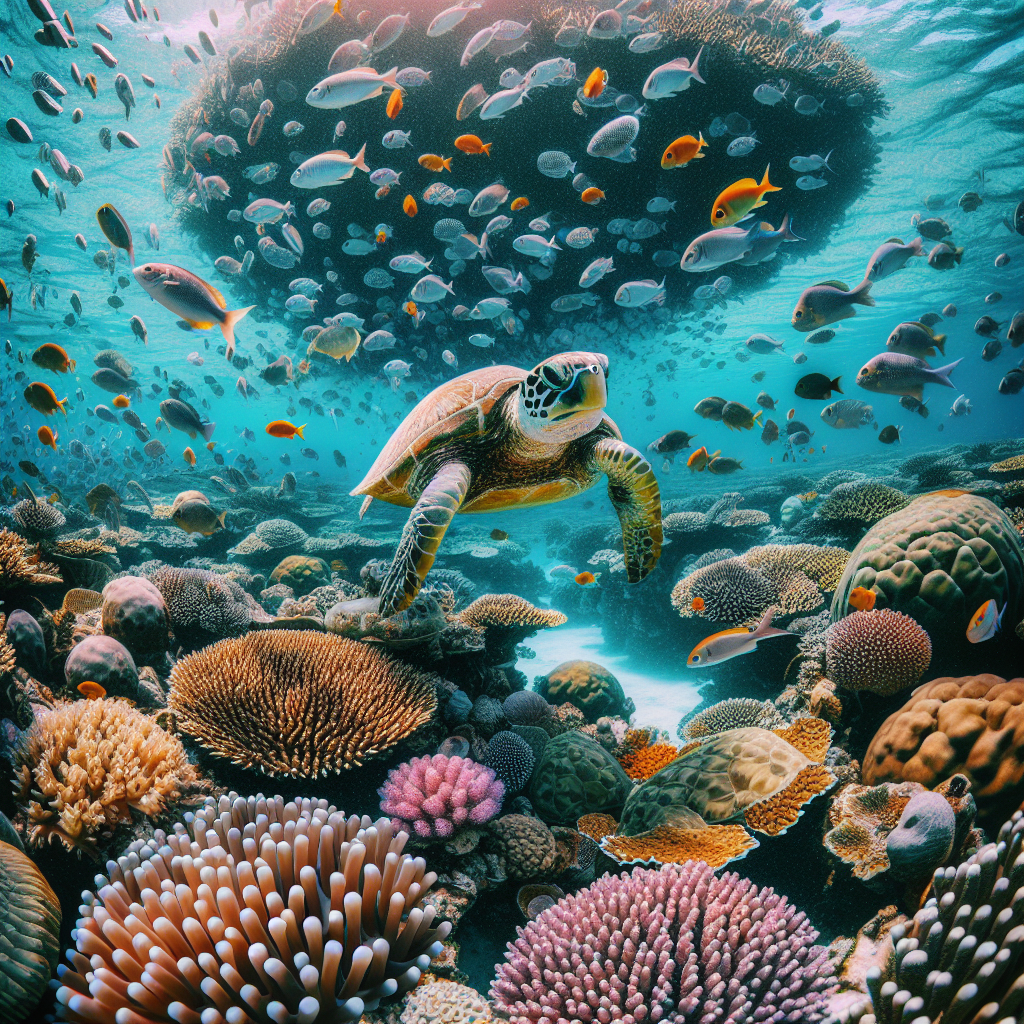Three years ago, the coral reef around Mnemba Island in Tanzania was almost dead because of climate change and too much fishing. The people on the island started a project to save the reef. They grew small pieces of coral in underwater nurseries and then planted them back on the reef. This helped bring back 80% of the coral and also created new reefs to attract fish and tourists.
The project worked well because the local people, a tourism group, a non-profit, and the government all worked together. The government made the area around the island a protected zone. They also limited the number of visitors and charged higher fees. Fishing was stopped near the reef, which helped reduce illegal fishing and taught fishermen better ways to fish.
Seeing the success, the Zanzibar government wants to do the same in other places. They found 14 areas with healthy reefs and some with damaged ones to protect. They put markers in the water to stop fishing in these spots. The project can’t stop the sea from getting warmer, but it aims to bring the reefs back to how they were and hopes to inspire others to do the same.
Original news source: How islanders are saving their Indian Ocean coral reef (BBC)
🎧 Listen:
Slow
Normal
Fast
📖 Vocabulary:
| 1 | coral | A hard, colorful material made by tiny sea animals |
| 2 | nurseries | Places where young plants or animals are grown |
| 3 | attract | To make someone or something come closer |
| 4 | protected | Kept safe from harm |
| 5 | limited | Not allowed to go beyond a certain number or amount |
| 6 | illegal | Against the law |
| 7 | fishermen | People who catch fish for a living |
| 8 | success | Achieving a goal or doing well |
| 9 | damaged | Broken or harmed |
| 10 | markers | Objects used to show a specific place or area |
| 11 | inspire | To make someone want to do something |
| 12 | climate | The usual weather in a place over a long time |
Group or Classroom Activities
Warm-up Activities:
– Charades
Instructions: Divide the class into small groups. Give each group a list of words related to the article (e.g. coral, fishing, tourism, government). One student from each group will act out a word without speaking while the other students in the group guess what word it is. The group that guesses the most words correctly wins.
– News Summary
Instructions: Have the students read the article individually or in pairs. Then, ask them to write a summary of the article in their own words. After they finish, have them share their summaries with a partner and compare their responses. Finally, have a class discussion to share the different summaries and discuss any discrepancies or interesting points.
– Opinion Poll
Instructions: Divide the class into pairs or small groups. Each group will come up with a question related to the article (e.g. Do you think coral reefs can be saved? Should the government limit the number of tourists in protected areas?). Have the groups ask their question to other groups and record their responses. Afterward, have a class discussion to share the different opinions and reasons behind them.
– Vocabulary Pictionary
Instructions: Provide the students with a list of vocabulary words from the article (e.g. coral reef, fishing, tourism, government). Divide the class into pairs. One student from each pair will draw a picture representing a word while the other student guesses what word it is. The pair that guesses the most words correctly wins.
– Think-Pair-Share
Instructions: Have the students read the article individually or in pairs. Ask them to think about a question related to the article (e.g. How can individuals help protect coral reefs?). Then, have them pair up with a partner and discuss their question. Finally, bring the class back together and ask a few students to share their partner’s response and discuss as a whole class.
🤔 Comprehension Questions:
1. What happened to the coral reef around Mnemba Island three years ago?
2. How did the people on the island help save the reef?
3. Who worked together to make the project successful?
4. What did the government do to protect the area around the island?
5. Why did they limit the number of visitors and charge higher fees?
6. What did they do to reduce illegal fishing and teach fishermen better ways to fish?
7. What does the Zanzibar government want to do in other places?
Go to answers ⇩
🎧✍️ Listen and Fill in the Gaps:
Three years ago, the (1)______ reef around Mnemba Island in Tanzania was almost dead because of climate (2)______ and too much fishing. The people on the (3)______ started a project to save the reef. They grew small pieces of coral in underwater nurseries and then planted them back on the reef. This helped bring back 80% of the coral and also created new reefs to attract (4)______ and (5)______.
The (6)______ worked well because the local people, a tourism group, a non-profit, and the government all worked together. The government made the area around the island a protected zone. They also limited the number of visitors and charged higher fees. Fishing was stopped near the reef, which helped reduce illegal (7)______ and taught fishermen better ways to fish.
Seeing the (8)______, the Zanzibar government wants to do the same in other (9)______. They found 14 areas with (10)______ reefs and some with damaged ones to protect. They put markers in the water to stop fishing in these spots. The project can’t stop the sea from getting (11)______, but it aims to bring the reefs back to how they were and hopes to inspire (12)______ to do the same.
Go to answers ⇩
💬 Discussion Questions:
Students can ask a partner these questions, or discuss them as a group.
1. What is a coral reef?
2. How do you think the people on Mnemba Island felt when they saw the coral reef dying?
3. Do you think it’s important to protect the environment? Why or why not?
4. How would you feel if you saw a coral reef for the first time?
5. What do you think the local people, tourism group, non-profit, and government did to save the coral reef?
6. Do you like swimming in the ocean? Why or why not?
7. How would you feel if you saw a lot of fish swimming around a coral reef?
8. What do you think the Zanzibar government wants to achieve by protecting other coral reefs?
9. Do you think it’s important for different groups to work together to protect the environment? Why or why not?
10. How would you feel if you couldn’t go fishing near a coral reef?
11. What do you think the markers in the water are for?
12. Do you think other countries should also protect their coral reefs? Why or why not?
Individual Activities
📖💭 Vocabulary Meanings:
Match each word to its meaning.
Words:
1. coral
2. nurseries
3. attract
4. protected
5. limited
6. illegal
7. fishermen
8. success
9. damaged
10. markers
11. inspire
12. climate
Meanings:
(A) The usual weather in a place over a long time
(B) Places where young plants or animals are grown
(C) Against the law
(D) To make someone or something come closer
(E) To make someone want to do something
(F) Objects used to show a specific place or area
(G) Achieving a goal or doing well
(H) Kept safe from harm
(I) Broken or harmed
(J) Not allowed to go beyond a certain number or amount
(K) A hard, colorful material made by tiny sea animals
(L) People who catch fish for a living
Go to answers ⇩
🔡 Multiple Choice Questions:
1. What was the problem with the coral reef around Mnemba Island?
(a) It was too crowded with tourists.
(b) It was almost dead because of climate change and too much fishing.
(c) It was too hot for the coral to survive.
(d) It was polluted with trash.
2. How did the people on the island save the reef?
(a) They grew small pieces of coral in underwater nurseries and planted them back on the reef.
(b) They built a wall around the reef to protect it.
(c) They moved the coral to a different island.
(d) They stopped all fishing in the area.
3. Who worked together to make the project successful?
(a) Only the local people.
(b) Only the government.
(c) The local people, a tourism group, a non-profit, and the government.
(d) Only the non-profit.
4. What did the government do to protect the area around Mnemba Island?
(a) They built a hotel on the island.
(b) They allowed more fishing near the reef.
(c) They made it a protected zone and limited the number of visitors.
(d) They charged lower fees for visitors.
5. What did the project do to reduce illegal fishing?
(a) Stopped fishing near the reef.
(b) Taught fishermen better ways to fish.
(c) Put markers in the water to stop fishing in certain spots.
(d) All of the above.
6. What does the Zanzibar government want to do in other places?
(a) Build more hotels near the reefs.
(b) Protect healthy reefs and damaged ones.
(c) Stop all fishing in the ocean.
(d) Move the damaged reefs to a different location.
7. How does the project aim to bring the reefs back to how they were?
(a) By stopping the sea from getting warmer.
(b) By charging higher fees for visitors.
(c) By building underwater nurseries.
(d) By planting small pieces of coral back on the reef.
8. What does the project hope to inspire others to do?
(a) Stop all fishing in the ocean.
(b) Move damaged reefs to a different location.
(c) Charge higher fees for visitors.
(d) Protect and restore coral reefs.
Go to answers ⇩
🕵️ True or False Questions:
1. The project’s success was due to the collaboration between the local people, a tourism group, a non-profit, and the government.
2. The government made the area around the island a protected zone and limited the number of visitors, charging higher fees.
3. The Zanzibar government does not support replicating the project in other places and has identified 14 areas with healthy and damaged reefs to monitor.
4. The people on the island started a project to save the reef by growing small pieces of coral in underwater nurseries.
5. Fishing near the reef was allowed, increasing legal fishing and providing fishermen with greater opportunities.
6. They planted the grown coral back on the reef, which helped bring back 80% of the coral and created new reefs to attract fish and tourists.
7. The project aims to maintain the reefs in their current state and hopes to raise awareness about the importance of conservation efforts.
8. The coral reef around Mnemba Island in Tanzania was flourishing three years ago because of climate change and sustainable fishing practices.
Go to answers ⇩
📝 Write a Summary:
Write a summary of this news article in two sentences.
Check your writing now with the best free AI for English writing!
Writing Questions:
Answer the following questions. Write as much as you can for each answer.
Check your answers with our free English writing assistant!
1. What happened to the coral reef around Mnemba Island three years ago?
2. How did the people on the island help save the reef?
3. Who worked together to make the project successful?
4. What did the government do to protect the area around the island?
5. What is the Zanzibar government planning to do in other places?
✅ Answers
🤔✅ Comprehension Question Answers:
1. What happened to the coral reef around Mnemba Island three years ago?
The coral reef around Mnemba Island was almost dead because of climate change and too much fishing.
2. How did the people on the island help save the reef?
The people on the island grew small pieces of coral in underwater nurseries and then planted them back on the reef.
3. Who worked together to make the project successful?
The local people, a tourism group, a non-profit, and the government all worked together to make the project successful.
4. What did the government do to protect the area around the island?
The government made the area around the island a protected zone.
5. Why did they limit the number of visitors and charge higher fees?
They limited the number of visitors and charged higher fees to help protect the reef and reduce the impact of tourism on it.
6. What did they do to reduce illegal fishing and teach fishermen better ways to fish?
They stopped fishing near the reef to reduce illegal fishing and taught fishermen better ways to fish.
7. What does the Zanzibar government want to do in other places?
The Zanzibar government wants to protect other areas with healthy and damaged reefs by putting markers in the water to stop fishing in those spots.
Go back to questions ⇧
🎧✍️✅ Listen and Fill in the Gaps Answers:
(1) coral
(2) change
(3) island
(4) fish
(5) tourists
(6) project
(7) fishing
(8) success
(9) places
(10) healthy
(11) warmer
(12) others
Go back to questions ⇧
📖💭✅ Vocabulary Meanings Answers:
1. coral
Answer: (K) A hard, colorful material made by tiny sea animals
2. nurseries
Answer: (B) Places where young plants or animals are grown
3. attract
Answer: (D) To make someone or something come closer
4. protected
Answer: (H) Kept safe from harm
5. limited
Answer: (J) Not allowed to go beyond a certain number or amount
6. illegal
Answer: (C) Against the law
7. fishermen
Answer: (L) People who catch fish for a living
8. success
Answer: (G) Achieving a goal or doing well
9. damaged
Answer: (I) Broken or harmed
10. markers
Answer: (F) Objects used to show a specific place or area
11. inspire
Answer: (E) To make someone want to do something
12. climate
Answer: (A) The usual weather in a place over a long time
Go back to questions ⇧
🔡✅ Multiple Choice Answers:
1. What was the problem with the coral reef around Mnemba Island?
Answer: (b) It was almost dead because of climate change and too much fishing.
2. How did the people on the island save the reef?
Answer: (a) They grew small pieces of coral in underwater nurseries and planted them back on the reef.
3. Who worked together to make the project successful?
Answer: (c) The local people, a tourism group, a non-profit, and the government.
4. What did the government do to protect the area around Mnemba Island?
Answer: (c) They made it a protected zone and limited the number of visitors.
5. What did the project do to reduce illegal fishing?
Answer: (a) Stopped fishing near the reef.
6. What does the Zanzibar government want to do in other places?
Answer: (b) Protect healthy reefs and damaged ones.
7. How does the project aim to bring the reefs back to how they were?
Answer: (d) By planting small pieces of coral back on the reef.
8. What does the project hope to inspire others to do?
Answer: (d) Protect and restore coral reefs.
Go back to questions ⇧
🕵️✅ True or False Answers:
1. The project’s success was due to the collaboration between the local people, a tourism group, a non-profit, and the government. (Answer: True)
2. The government made the area around the island a protected zone and limited the number of visitors, charging higher fees. (Answer: True)
3. The Zanzibar government does not support replicating the project in other places and has identified 14 areas with healthy and damaged reefs to monitor. (Answer: False)
4. The people on the island started a project to save the reef by growing small pieces of coral in underwater nurseries. (Answer: True)
5. Fishing near the reef was allowed, increasing legal fishing and providing fishermen with greater opportunities. (Answer: False)
6. They planted the grown coral back on the reef, which helped bring back 80% of the coral and created new reefs to attract fish and tourists. (Answer: True)
7. The project aims to maintain the reefs in their current state and hopes to raise awareness about the importance of conservation efforts. (Answer: False)
8. The coral reef around Mnemba Island in Tanzania was flourishing three years ago because of climate change and sustainable fishing practices. (Answer: False)
Go back to questions ⇧













